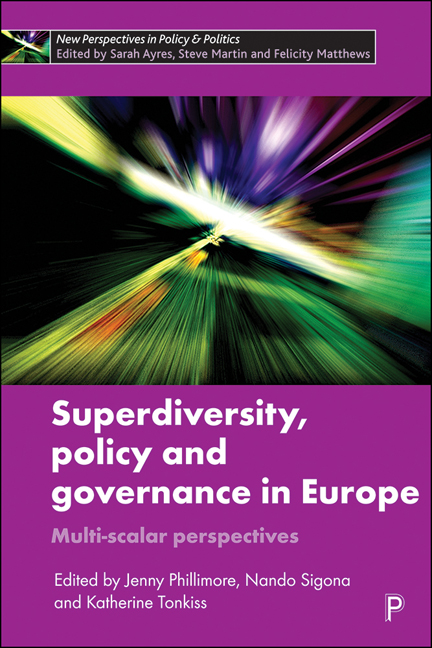Book contents
- Frontmatter
- Contents
- List of Figures and Tables
- Notes on Contributors
- Introduction: Superdiversity, Policy and Governance in Europe
- Chapter One Managing Superdiversity? Examining the Intercultural Policy Turn in Europe
- Chapter Two Mainstreaming in Response to Superdiversity? The Governance of Migration-Related Diversity in France, The UK and the Netherlands
- Chapter Three Making the Most of Superdiversity: Notes on the Potential of a New Approach
- Chapter Four Superdiversity and Sub-National Autonomous Regions: Perspectives from the South Tyrolean Case
- Chapter Five Transmigration: The Rise of Flexible Migration Strategies as Part of Superdiversity
- Chapter Six Superdiversity, Multiculturalism and Local Policies: A Study on European Cities
- Chapter Seven Integrating Superdiversity in Urban Governance: The Case of Inner-city Lisbon
- Chapter Eight Urban Planning and the Challenge of Superdiversity
- Chapter Nine Superdiversity in the Post-Industrial City: A Comparative Analysis of Backlash Narratives in Six European Neighbourhoods
- Index
Chapter Eight - Urban Planning and the Challenge of Superdiversity
Published online by Cambridge University Press: 04 March 2021
- Frontmatter
- Contents
- List of Figures and Tables
- Notes on Contributors
- Introduction: Superdiversity, Policy and Governance in Europe
- Chapter One Managing Superdiversity? Examining the Intercultural Policy Turn in Europe
- Chapter Two Mainstreaming in Response to Superdiversity? The Governance of Migration-Related Diversity in France, The UK and the Netherlands
- Chapter Three Making the Most of Superdiversity: Notes on the Potential of a New Approach
- Chapter Four Superdiversity and Sub-National Autonomous Regions: Perspectives from the South Tyrolean Case
- Chapter Five Transmigration: The Rise of Flexible Migration Strategies as Part of Superdiversity
- Chapter Six Superdiversity, Multiculturalism and Local Policies: A Study on European Cities
- Chapter Seven Integrating Superdiversity in Urban Governance: The Case of Inner-city Lisbon
- Chapter Eight Urban Planning and the Challenge of Superdiversity
- Chapter Nine Superdiversity in the Post-Industrial City: A Comparative Analysis of Backlash Narratives in Six European Neighbourhoods
- Index
Summary
Introduction
This chapter is a first major attempt to explore the role of urban planning in responding to migration-related superdiversity. While previous research has been undertaken on urban planning and the multicultural city (Fincher et al, 2014; Burayidi, 2003; Sandercock, 2003; 1998; Qadeer, 1997) as well as planning and diversity in the city (Fincher and Iveson, 2008; Uyesugi and Shipley, 2005; Baumann, 1996), little attention to date has focused on the challenges of increasing superdiversity for urban planning.
Superdiversity describes a demographic condition in which populations are more diverse than ever before (Vertovec, 2007). Vertovec argues that superdiversity has been driven by new migration wherein migration pathways are no longer dominated by post-Commonwealth relationships, and with the patterning of immigrants changing from many migrants moving to a few places to fewer migrants moving to many places (Vertovec, 2007; Phillimore, 2013). The scale, complexity, heterogeneity, fragmentation of populations and speed and spread of change associated with superdiversity exceeds any previously experienced (Meissner and Vertovec, 2015).
While it is acknowledged that almost everywhere, rural and urban, has become more diverse, the scale, speed and spread of superdiversity varies by country and by settlement area, and with large urban centres most affected (Vertovec, 2007). Superdiversity is in evidence in major cities such as London (29 per cent from ethnic minority backgrounds and from over 170 countries) (GLA, 2005), and Birmingham, where GP registration data has shown that 41,318 migrants moved to the city from 187 different countries between 2007 and 2010 (Phillimore, 2013).
Super-diverse areas may be ‘layered’, and accommodating both old and new migrants, as well as long-standing non-migrant populations. While no tipping-point has yet been identified between being a multicultural area and a super-diverse area, what is important to recognise is that superdiversity espouses the idea of communities being so diverse that there are no dominant ethnic groups. As such, it moves beyond the idea of multicultural communities consisting of a small number of ethnic groups with similar origins frequently living in close proximity to each other as distinct diaspora (Pemberton and Phillimore, 2016).
- Type
- Chapter
- Information
- Superdiversity, Policy and Governance in EuropeMulti-scalar Perspectives, pp. 168 - 191Publisher: Bristol University PressPrint publication year: 2020



